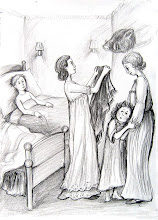White, Roberta. "Journey to the Silent Kingdom: Virginia Woolf's To the Lighthouse." A Studio of One's Own: Fictional Women Painters and the Art of Fiction. New Jersey: Rosemont & Printing Corp., 2005. 85-108. Print.
Within Roberta White’s article “Journey to the Silent Kingdom: Virginia Woolf’s To the Lighthouse,” she expresses a point of view that describes Lily Briscoe as an influential literary character due to her artistic abilities, while also explaining factual information about Virginia Woolf and her attempt to wed the two art forms of painting and writing. White discusses Woolf’s love of painting and observations of the visual arts, while also expressing Woolf’s attempt to portray the painter’s mind through the character of Lily Briscoe. One main focus that White continually states is the mimicking of the artistic process that Woolf constantly tries to portray within her work. Woolf states that there are three ways of looking at the artistic process, “first, by reacting to color…second, by seeing the painting in a literary way and attempting to express its meaning in words; and third, by trying to experience the painting as artists do in their own wordless realm” (90). By understanding the love that Woolf had for the visual arts, as well as the effort that was made in recording such a process as painting, White is successful in presenting the point of view of Lily Briscoe’s presence as an influential literary character.
This particular article is an excellent reference to the present research question. The focus of White’s novel as a whole is the existence of female painters within literature, and the chapter described above is dedicated entirely to Lily Briscoe and her author, Virginia Woolf. The article is able to aid in answering the research question due to the fact that it specifically explains Woolf’s attempt to show the inner artistic process of Lily. By understanding the process in Lily’s head, one is able to better understand the direction that Woolf’s narration goes towards. White clearly states Lily’s attempt to create a vision of “Surface and structure” which then leads her to say, “Woolf distinguishes between Lily’s artistic vision of the painting and her actual work in progress” (94). The essence of this article is focusing on Woolf’s attempt to record a painter’s artistic process, while Woolf herself tries to mirror that process through her writing; that alone is evidence of the article’s ability to contribute greatly to the research question.
Subscribe to:
Post Comments (Atom)



No comments:
Post a Comment